This blog was written to supplement the Puppy Paws Episode 4 video. If you haven't seen the Puppy Paws videos you can watch them on the kennels page. Read on if you are curious to know more about what traits, both physical and mental, we are looking for in our puppies.
We get a great sense of who each of our puppies are just by spending so much time with them every day. We are lucky in that we have endless opportunities to observe how each puppy interacts with thousands of new people, how they socialize with their littermates as well as the adult dogs in the kennel, where they like to run in the puppy pack during walks and countless other chances to see just who each puppy might grow up to be.
For the past few summers we have also been experimenting with more formal means of puppy evaluation. We breed only one litter of pups each year and we want just enough pups to replace the litter that is retiring. Generally, we have about 4 dogs from each litter or age group in the kennels from newborn pups up to 9 or ten years old. If a litter has more pups than we need to replace the retiring group that year we will adopt them out. Because our bloodlines of large, freighting dogs are so rare we work closely with a few other kennels who raise and work with similar dogs and often share breedings with them. The more that we can learn about our puppies physical and personality traits the more we can understand what will lead to a great working dog for our kennels. These evaluations will then help us to make the most informed decision about which pups to keep here, which pups to adopt to other working kennels, and which pups might prefer to be a pet in a very active household rather than a member of a working dog team. It is generally agreed that the best time for personality testing is when each pup is about 7 weeks old (49 days) because that is when neurological development has reached adult levels giving us the clearest picture of their behavioral tendencies. If testing is done too early in life the pup is still too neurologically immature. If it is done later the pup is in a fear development period between 8-10 weeks old and therefore test results may not be accurately indicative of their personality. The test that we used is the Volhard Puppy Aptitude test (See http://www.caradobe.com/volhardtest.pdf)
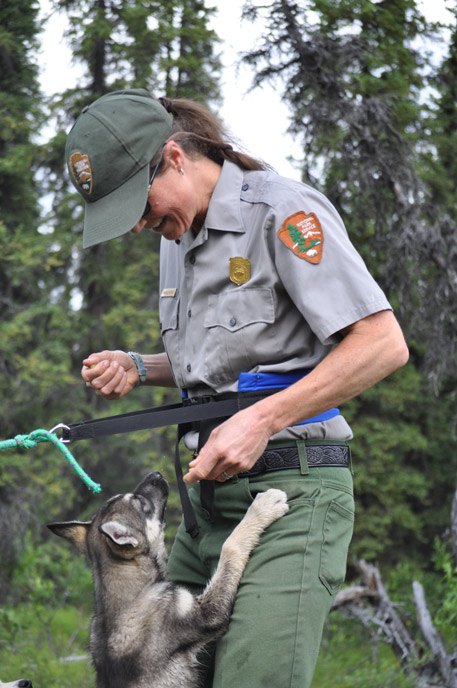
Polly on a training walk with Jen. NPS photo.
The first part of the test (social attraction, following, restraint, social dominance, elevation dominance) addresses individual temperament (dominance vs. submission and independence vs. social attraction) sociability and attraction to people. It indicates how readily a pup will accept human leadership.
The second part of the test (retrieving, touch sensitivity, sound sensitivity, sight sensitivity) addresses obedience aptitude or trainability as a working dog. It provides a picture of the pup's intelligence, spirit, and willingness to work with a human.
The second part of the test (retrieving, touch sensitivity, sound sensitivity, sight sensitivity) addresses obedience aptitude or trainability as a working dog. It provides a picture of the pup's intelligence, spirit, and willingness to work with a human.
The test is always done in a new environment that is unfamiliar to the pups and is performed by a third party who does not already have strong relationships with the pups. I was managing the pups in the back room while the testing was going on. Elizabeth Beavers and Dan Irelan performed the test and Alex VanDerStuyf video recorded the pup's responses.
What We Learned
Annie is an outgoing and friendly pup who will adjust well to most situations when she gets regular training and exercise. We'd agree with that given all the daily situations we see her in in the dog yard. She loves to greet the big dogs. She loves to play with people. She has a lot of energy and will torment her siblings to play until she is finally tired. Annie's favorite thing to do is play with others. She is a social butterfly in the dogyard, on walks, even on runs around the demo track she is likely to veer off to go visit Auntie Chulitna in the dogyard. She is an exuberant, joyful dog. She may not be quite as determined or focused as Polly, but she will likely grow up to be a great sled dog and maybe even an inspiring leader for the team.
 Annie shows her happy personality. NPS photo.
Annie shows her happy personality. NPS photo.Lucky is more submissive and mellow and needs leadership from humans or other dogs. He may need a very predictable training environment to be successful. We have noticed that Lucky watches his sisters for cues on what to do in any new situation and then quickly joins right in the fun. When we work on his training we will push him gently and slowly so that he has plenty of time to get comfortable with each new challenge. Lucky may mature later than his sisters and may take a little bit longer to feel comfortable being the lead dog in charge of the team and that is okay. We bet he is going to be a big, strong, hardworking dog wherever we put him in the team.
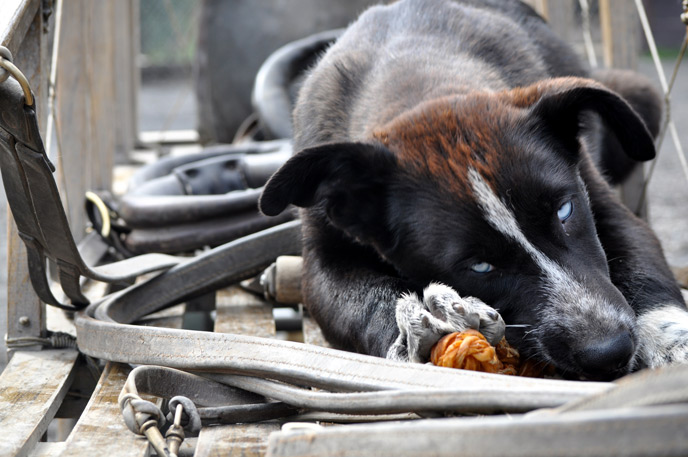
Lucky enjoys some quiet time with his bone. NPS photo.
Polly is a bit more independent than either of her siblings. This may serve her well someday as a lead dog where we rely on the dogs to have the confidence to find the best trail in deep snow or across challenging river ice. She won't look to humans to tell her what to do in a tough situation; she'll have the guts to figure it out for herself. We have already seen that Polly loves to lead the puppy pack out on walks. She's fast and happy to discover her own path everywhere we go. She loves running back and forth through the creek water and has yet to be timid about any new thing she encounters out on the trail. We'll have to wait a few years to see if she grows into the exceptional lead dog we imagine she will become.
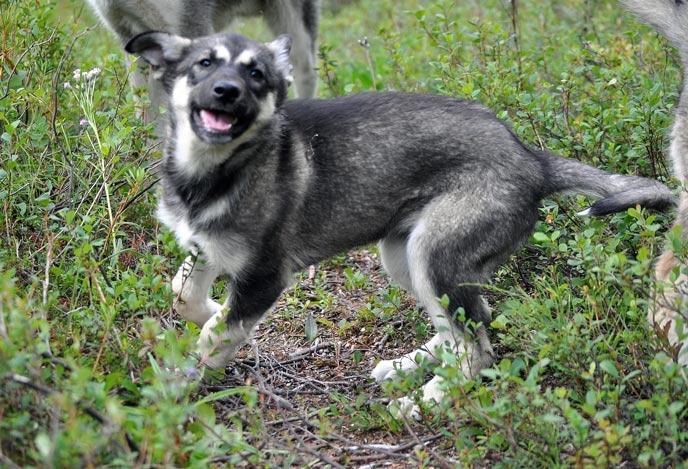
Polly loves to lead the pack on puppy walks. NPS photo.
Pat Hastings Puppy Structural Evaluation
At exactly 8 weeks old Pat Hastings believes that puppies are the exact miniature of what their adult bodies will look like. Her philosophy is that the better a dog is built the better they will be able to perform their job as working sled dogs. A dog that does not have a proper physical structure may suffer more injuries or behavioral problems because they are struggling or they may just tire out easier from compensating for their own weaknesses. It is helpful to know which of our dogs have the best possible structure for the work that they do as sled dogs in winter, in terms of making future breeding decisions.
We take photos of our puppies in different stances and then send them to Pat for her to review. Pat is very patient and skilled to work with us as we are not an AKC show kennel and our dogs and humans are not well trained in holding these very specific poses. You will see that in some of our still photos the dogs are not perfectly positioned to display their true build. This is due to my learning curve in posing them. Hopefully, each year we work with Pat I will improve. However, I am pretty sure that each year's new litter of pups will remain just as squirrely as they discover the taste of cheese or sausage that we use to try to have them stand perfectly still for the first time in their puppy lives.In general she is looking at the front assembly of our dogs, the rear assembly and the topline connecting the two.
A dog that is well proportioned will have the ability to develop great muscle to do their work. If their structure is poor, they will be lacking in muscle attachment points and won't have the same mass to support their joints or movements. A dog with a well angulated shoulder and proportional front end should have a good reach in their gait which allows them to efficiently cover the ground when they move. Since our sled dogs run many miles each day this efficiency of motion is very important for them. Sled dogs also need a strong rear end for their driving power to dig in and pull a heavy sled through the snow. Disproportionate rear legs can lead to excessive wear and tear on the joints and ultimately arthritis or other injuries. Our dogs wear harnesses that fit over their chest, shoulders, and back to distribute the weight that they are pulling and allow them to lean into their harness to gain pulling power. Therefore, their withers need to be just right and not too high or it could be painful to wear a harness and their backs need to be proportional and strong. All of this is a great simplification of the many details that can be observed and evaluated in a dog. I am thankful that Pat's trained eye can pick all of these traits out and help teach us how to see them better with each litter we have.
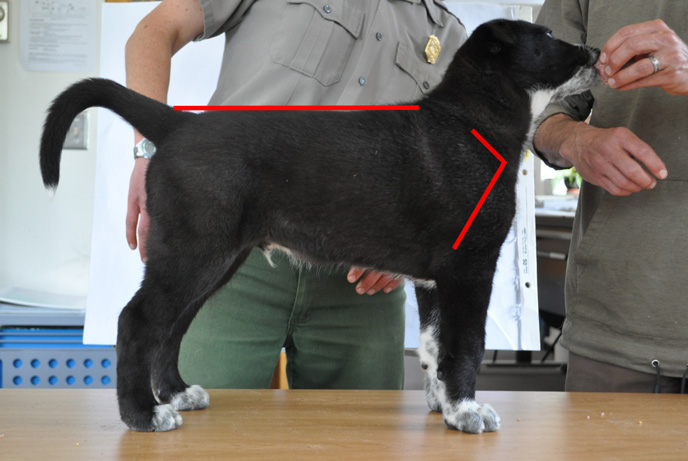
A straight top line and angulated shoulder are characteristics that are scored in Pat Hastings puppy evaluations. NPS photo.
As Pat says, "Awareness is the first best step to enhancing our lives and relationships and can make all the difference in our partnerships with our dogs." So how do we use her evaluations? Right now we use them to learn about our dogs and raise our awareness. We compare how we see our dogs performing each winter with what Pat's puppy evaluations identified in each of them. We'll have to wait a few more years to see if there is a particular puppy structure that grows up to be our best adult sled dog. For now it is one more tool that helps us understand how we can help each of our pups grow up to be the best sled dog possible and then to breed the best adult dogs possible to get more great puppies in the future.
So, Who is the Perfect Puppy?
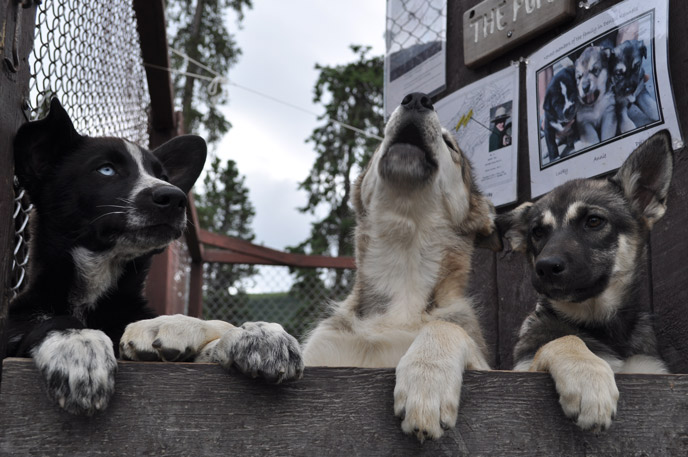
Lucky, Annie and Polly are all wonderful puppies in our eyes. NPS photo.
We would say that each of these guys is. These evaluations are just one more tool in our very large toolbox. Sometimes the dog who doesn't have the greatest body may still have the biggest heart and turn out to be a once in a lifetime sled dog. So none of these tests are deciding factors for us; they are just educational tools to help us learn about and better understand our dogs. I fully expect that our pups will surprise us on the trail this winter and in years to come. That's the amazing and inspiring thing about sled dogs ̶ their passion for their job drives them to do the seemingly impossible on a daily basis.
